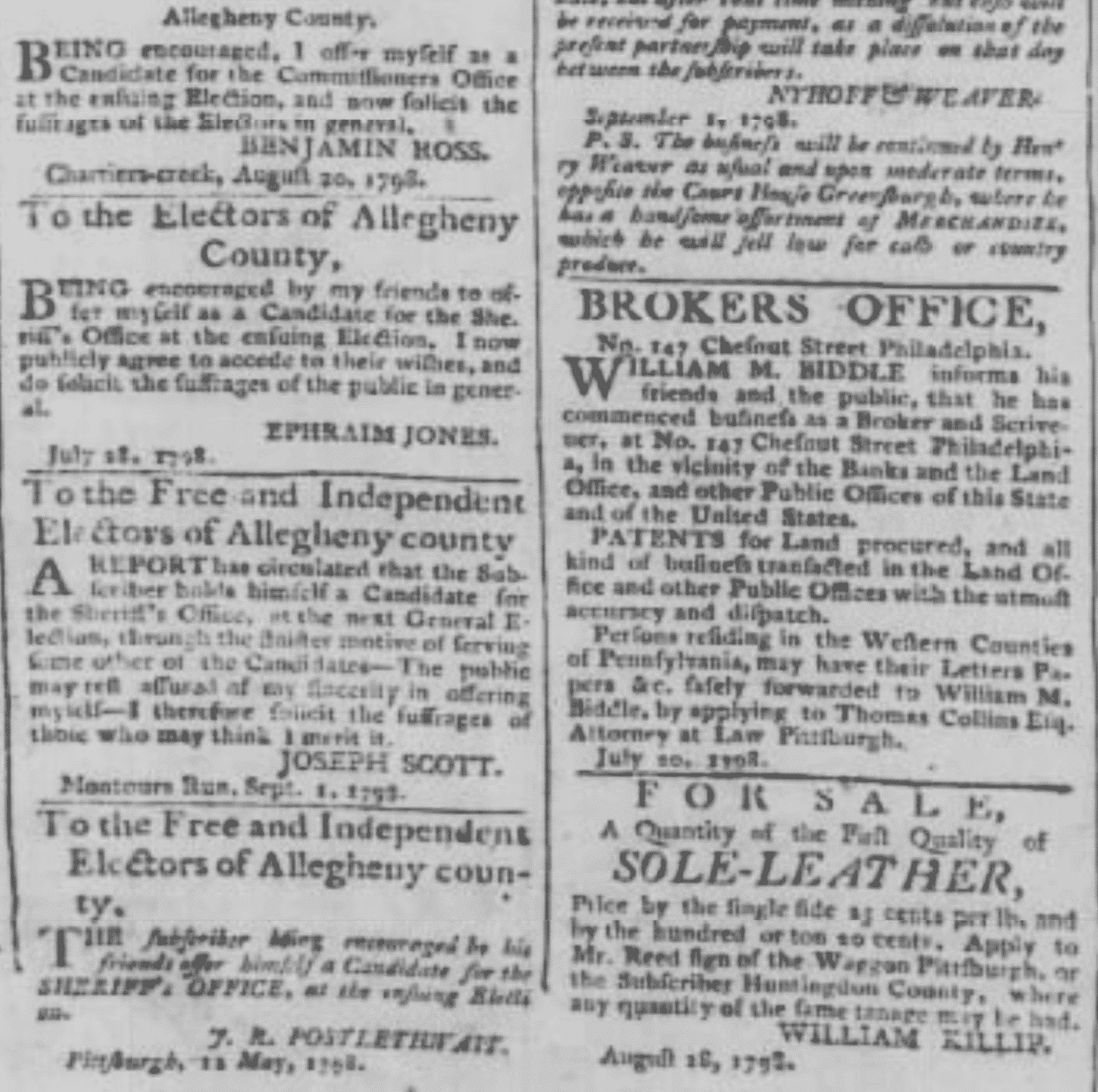Since time immemorial media relations, or some variation of it, has been used to influence public opinion on brands, products and services. Back in the day, old-school media relations would involve calling up “Danstun & Frank Publishing Co.” (not a real company) and ordering some pamphlets, perhaps a spot on the local town’s wall and, if lucky, get a mention in the local paper.
Prior to digital media and TV, newspapers were the only real source of information outside of one’s bubble and every column would be scoured for interesting tidbits, news, property sales, insights, products and opinions.
Let’s take the Pittsburgh Weekly Gazette. One of the oldest papers in America, dating back to the 1700s. Here we see product and service listings with very uniquely written entries. You have to appreciate the candidness of these. Just pure “say it how it is”, without keyword padding, SEO influence, exaggeration or anything more.
 Entry from the Pittsburgh Weekly Gazette, 15 Sept 1798
Entry from the Pittsburgh Weekly Gazette, 15 Sept 1798
Let’s say we take the last entry (bottom right) and parallel it against modern media relations services. Let’s say Mr William Killip wanted to use media to market himself in 2017. Let’s also say, for the sake of a study that his Sole-Leather was a national company and wholesale supplier to many brands and was currently trying to resolve a challenge of having a ton of stock yet not being “mainstream” enough to attract the size of clients he needs.
This is pretty much the problem of every VC-infused Startup and even stagnant old-timer companies who never could quite make it off the ground.
Media Relations would be used like this.
- Define the product demand required and goals of the company.
- Define the problem they solve for their target market.
- Determine the keywords required to target that market.
- Determine the media locations most likely to be subscribed to by those customers.
- Implement a dual purpose media/press program get it done.
The Dual Purpose Media Program
Credibility Building
Internet users are getting smart. They know if they see a company which has little or no online presence then there is something wrong. And they are correct. Any brand which cares about their customers will have online mediums to communicate, discuss and share material. So for William Killip’s Sole-Leather Co. we would ensure they the first impact of a search results in overwhelming confidence. Google results would like like this:
- WKSoleLeather.com
- WKSoleLeather Wiki Page
- WKSoleLeather LinkedIn
- WKSoleLeather Forbes
- WKSoleLeather CNNmoney
- WKSoleLeather Entrepenuer
- WKSoleLeather Huffington Post
- WKSoleLeather Inc.com
And on an on with Media placements, written by journalists, influencers who have interviewed My Killip and even have tested the product.
Example titles:
VC’s Eyeing Sole-Leather Inc as hottest silent wholesaler takes on retail giants
A Company with a Soul – William Killip Launches Leather Supply Empire
So that’s Credibility done.
Keyword Targeting
As we wrote earlier, PR is the new Search Engine Optimization (SEO) process which every company should use. For the last 20 years only the biggest SEO agencies used PR to scale and dominate. Global sites such as TripAdvisor, Hotels.com, Microsoft, PriceLine.com and many others dominate Google searches for hundreds of thousands of keywords because they use one thing: High credibility PR, influencer blogs and platforms to talk about them.
So with Mr Kippler’s Sole-Leather Co. we would do the same:
- Mr Kippler wants his company to be found for “Leather supplies, leather suppliers, wholesale leather, cheap leather, shoe leather and a dozen other search terms.
- The media relations team would ensure that any press and online references would point back to their website or, at minimum, talk about these topics within their article.
- This would be repeated over and over again for each category, geographic location and online resource.
- The media would then be shared and discussion would be started around it on all platforms.
- The story is told, the keywords are focused on, the search results are dominated.
So, one could say that Mr Kippler would have had much more opportunity of success in today’s world. Media relations is a powerful tool and could be said, the most powerful communications medium to the national or global audience.
To find out how you can be a Mr Kippler and reach out to us today for a free consultation.





